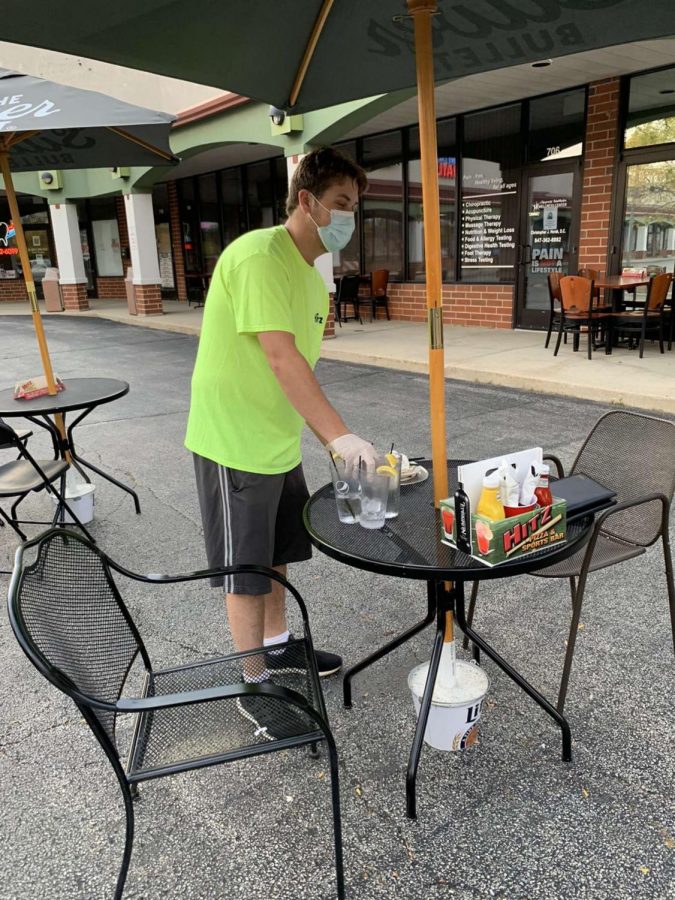Students experience work-life during the pandemic
Summer jobs are a common part of one’s teenage years; whether it’s being a camp counselor, working at a pizza place, or serving as a lifeguard. This summer, however, looked a little different. Masked faces became the new norm, workplaces became dotted with strong scented hand sanitizers, companies either thrived or struggled, and the job search process shifted.
The coronavirus came quickly to the United States, forcing lockdown upon our schools around March 17th. School events and activities were cancelled as well as in-person learning. Our lives initially changed as we began to binge on buying hand sanitizer and toilet paper. Then came the masks of all sorts and the six feet distance.
Finding a job in our state varied in difficulty during the pandemic. After surveying VHHS students in a TSP survey, the average rating was a five out of ten from 30 student responses: with one being “Extremely Easy” and ten being “Very Difficult.” While some students explained how the pandemic caused more workplaces to hire new workers, others believed that it restricted the number of employees needed in order to maintain a safe environment.
Jordan Pinksy (12), a current senior at VHHS working at Hitz Pizza, explained how he landed his job during the pandemic.
“I would say I got this job more by luck because I’ve been going to Hitz forever after baseball games as a kid. I knew the management and they knew who I was, and they were just in need of one busboy. So it kind of just worked out perfectly, and I was in need of another job,” said Pinsky (12).
After being hired for a job, about 90% of students surveyed reported that new COVID-19 regulations had been set in place. These regulations included wearing masks, temperature checks, writing lists of symptoms, wearing gloves, and keeping distance from one another. Students also noted that these regulations affected the atmosphere of their workplace by increasing stress and decreasing ease in conversation between coworkers and customers.
Katie Goldstone (11), a junior working at Bella Familia and the Vernon Hills Family Aquatic Center, talked about how the new regulations have affected her and her workplace.
“At the pool, there has to be less people there. We have to be more spread out. So there’s only two people allowed in the break rooms. And then at the pizza place, there’s just less people in general working in the kitchen” said Goldstone (11).
With the pandemic, a workplace’s success depended on the type of business it was. While some businesses were thriving and even overstaffed, others seemed to struggle and were in need of more staff. Restaurants or shops that specialized in take-out or developed the new curbside pickup option gained popularity and sparked conversation.
For Pinsky (12), his pizza place blocked off part of the parking lot to create an outdoor seating experience that would attract more customers with the pandemic at hand. Yet, in general he still noted the inconsistency of business at his workplace, as it really depended on the day. With Hitz being takeout as well, though, they still seemed to thrive.
For Goldstone (11), on the other hand, she found that both of her workplaces were struggling.
“Both of them are struggling more just because not as many people are willing to go out with the disease present,” said Goldstone (11).
Seemingly, the pandemic helped benefit certain businesses with the ability to adjust more easily rather than those who were at a lack of funding or resources to do so.
Some businesses found themselves having to adjust their prices or pay. Macianos in Vernon Hills, for instance, had to raise the prices of their food items by small amounts in order to stay in business and continue to pay its staff.
For students transitioning into virtual school, some found it easier than others to maintain a job. Student survey responses varied from e-learning being easier to give them more hours during weekdays to work, to it making it much harder for students to work after being drained from a computer-based day. Yet, the majority seemed to agree that work was something they tended to look forward to after school, as it gives them an opportunity to finally get out of the house.
Due to the current situation, about 67% of students have still been able to keep their jobs during e-learning. Although the pandemic has put multiple regulations in place at student workplaces and added to some stress, lack of communication and overall varying success rates of businesses, many students were satisfied with their quarantine jobs as it allowed them to get out of the house and still be able to have in-person interactions.

